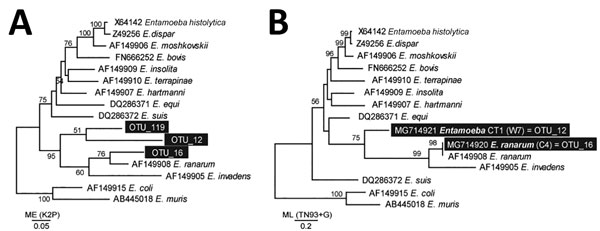Volume 24, Number 8—August 2018
Dispatch
Invasive Colonic Entamoebiasis in Wild Cane Toads, Australia
Figure 2

Figure 2. Phylogenetic inference of cane toad (Rhinella marina) Entamoeba SSU-rDNA sequences. Entamoeba SSU-rDNA sequences obtained using environmental next-generation amplicon sequencing (A) and conventional amplification using Entamoeba-specific primers (B) were aligned with available representative SSU-rDNA sequences. Each sequence is accompanied by GenBank accession number and Entamoeba species name. New sequences are in black boxes. Bootstrap support values (500 replicates) are shown next to the branches. The evolutionary distances were computed using the maximum-likelihood method and are in the units of number of base substitutions per site (SCALE BARS). New sequences are representative of the OTU contigs (A) or are sequences directly from PCR amplicon (B). OTU, operational taxonomic unit; SSU, small subunit.